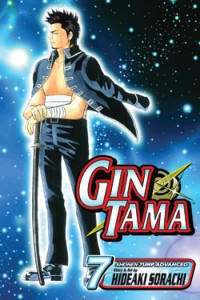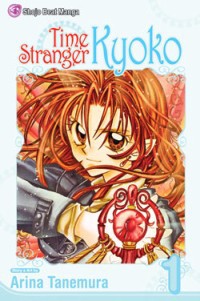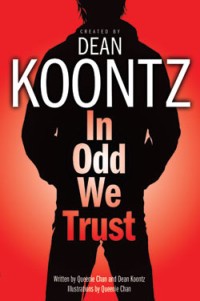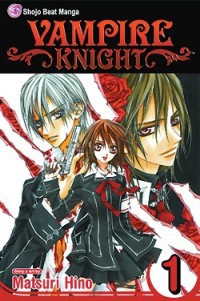RIGHT TURN ONLY!!
Strange Times
by Carlo Santos,

Between seeing Wall-E the other weekend, and the surprisingly decent ending of Absolute Boyfriend live-action, I've been thinking a lot about how humans love to build machines in their own image. We're still a long way away from self-aware artificial intelligence, but that doesn't stop us from projecting human attributes onto inanimate objects—people naming their computers, cars, iPods, game consoles, treating pieces of machinery like true friends—and even getting upset when they break down. And of course, as the classic Scott McCloud theory goes, we love seeing our own faces in just about everything...

GIN TAMA

Vol. 7
(by Hideaki Sorachi, Viz Media, $7.99)
FROM THE BACK COVER:
"The samurai didn't stand a chance. First, the aliens invaded Japan. Next, they took all the jobs. And then they confiscated everyone's swords. So what does a hotheaded former samurai like Sakata "Gin" Gintoki do to make ends meet? Take any odd job that comes his way, even if it means losing his dignity.
Yorozuya Hit List (Exploding Targets):
1. The Shinsengumi elite police and Gin (innocent bystander)
2. Chief Kondo and Gin's new work place (during their shift)
3. Human shields named Kondo, Yamazaki, and Gin
4. The special New Year's issue of Shonen Jump magazine and Gin
5. Gin's apartment (more than once)
6. Fireworks and ... not Gin
EVIDENCE FOR:
What is Shonen Jump all about? What is the meaning of "Friendship, Challenge, Victory"? This volume explains it all in one epic chapter where Gin and a rival fight over the last copy of SJ magazine on the newsstand. This isn't just the highlight of the book, but maybe even the entire series—one absolutely lucid moment where all the elements of screwball comedy come together. Heck, it even pulls off the old "jump on top of a moving truck as it drives under a bridge" gag ... twice! Other highlights include Gin tricking some carpenters into giving his home an extreme makeover, a heartwarming little tale about an old fireworks maker and his wife, and a madcap plot that somehow weaves together an Edo-period version of the Nigerian e-mail scam, an MIB-like alien invasion, and a surprise parental reunion for one of the main characters. Madcap action-comedy and unpredictable storytelling? Hideaki Sorachi, you're a man after my own heart. The unique background art that blends traditional Japan with industrial and sci-fi concepts sure helps, too.
EVIDENCE AGAINST:
What is Shonen Jump all about? Short, filler-y chapters where the artist putzes around for 20 pages while he tries to think of new ideas? The first three chapters are exactly like that, wallowing in a "Gin loses his memory" storyline until any humor that may have been there is completely sucked out. You see, it's Gin's self-centered laziness that makes him so funny, and giving him amnesia and turning him into a decent human being makes Gin decidedly not funny. And if Gin acting out of character for a full third of the book isn't bad enough, there's also a chapter where he doesn't even show up—instead, fellow rebel Katsura takes center stage in a run-of-the-mill sequence of chases and fights. Come on, "escape the Shinsengumi" is an idea that any Edo-period series could have come up with—where's all the wacky, barrier-breaking creative stuff? Oh, and of course the pacing gets bogged down as usual with too much dialogue; clearly 20 pages a chapter isn't enough room for saucy, smart-mouthed chatter.
FINAL VERDICT:
So good (in some of the stand-alone chapters), yet so mediocre (in the amnesia storyline)! The "I want that Jump magazine" chapter is an absolute gem, but is surrounded by lots of lesser material, averaging out to a B.
GUN BLAZE WEST

Vol. 2
(by Nobuhiro Watsuki, Viz Media, $7.99)
FROM THE BACK COVER:
"In the Old West only the strong survive. Viu Bannes is a boy on a mission to be the best gunfighter in the West. When Viu meets a vagabond gunslinger named Marcus Homer, his desire to be the best becomes even stronger. He knows it's his destiny to travel to the legendary land known as Gun Blaze West—where only the toughest gunmen dare set foot!
Five years after Marcus Homer's death, Viu's training is complete and he begins his quest in earnest. While passing through St. Louis, Viu meets Will Johnston, a rope master who shares Viu's mission ... and tenacity. Has Viu found a new rival in Will, or a new partner?!"
EVIDENCE FOR:
Guns! Violence! Action! Now that Viu is no longer a nine-year-old brat, the next Gun Blaze West is able to focus on some serious Wild West shootouts. A game of "Deadly Target" in St. Louis features some exuberant gunplay, but the real heart and soul of this volume comes when Viu faces off against a gang of sneering villains. This is the kind of over-the-top brilliance even Sergio Leone couldn't make up: using one's boot spurs in melee combat; wasting your other five bullets because you'll only need one; spotting imperceptible split-second movements thanks to intense visual focus. Of course, these displays of virtuosity would not be nearly as impressive without the bold, straight-shooting artwork, where speedlines are a way of life and characters move so fast that even their outlines become blurred. Viu may be a reckless hothead who'd get himself killed in the real Wild West, but as an action hero, those personality traits are exactly why his gun and his fists are capable of unbelievable, eye-popping feats.
EVIDENCE AGAINST:
Viu Bannes may be capable of eye-popping feats, but is he capable of learning from experience? Somehow, this kid is still clinging to the childish notion that he can solve all his problems by getting stronger, training like a madman, of course, shooting first and asking questions later. You know, there's a thin line between standing up for one's beliefs and being a stubborn idiot. He's not the only poorly imagined character in the story, either, as this volume also includes the most stereotypically Mexican villains ever (seriously, ponchos and sombreros?) and a token Japanese character. (Because, hey, you could set a manga in freakin' Antarctica and there'd still be a Japanese person somewhere.) Come back, Marcus Homer, you were the only well-developed character in the series! Meanwhile, the storyline continues to chug along with zero interesting turns—oh, he's still trying to head west while fighting a ton of people along the way—and the artwork is so lacking in nuance that they might as well be having a gunfight among the rocky outcroppings of Dragon Ball Z land. (Hmm, now there's an idea...)
FINAL VERDICT:
Great action and combat is no excuse for terrible everything else. This mindless entertainment floats along at a C- unless it suddenly gets way better next volume.
MUSHISHI

Vol. 4
(by Yuki Urushibara, Del Rey, $12.95)
FROM THE BACK COVER:
"Nebulous and unseen, existing in a state somewhere between life and death, mushi bring nothing but pain, suffering, and destruction to humans. A small community of wandering healers and naturalists known as mushishi protect humans from the ravages of these malevolent entities. Ginko, with his green eye and white hair, is a mushishi. But when Ginko tries to help a boy who seems to have found spring in the middle of winter, he and the boy both become victims of the life-sucking creatures."
EVIDENCE FOR:
I cried over a bamboo plant while reading this. Yes, the fourth Mushishi is that good, with a set of stories that hit a high point in showing off emotional subtlety and the wonders of nature. The stories in this volume are rarely happy, but it is that bittersweet quality that makes them linger in a much more powerful way: the separation of two sisters; a pair of doomed lovers; a husband who must accept his wife and daughter for what they are. And as Ginko passes through people's lives, he doesn't really offer solutions, only explanations—and in that way, we see that these go beyond mere narrative and are more like meditations on the human spirit. But enough Zen babble—if you want something more tangible to praise, there's always Yuki Urushibara's amazing renditions of nature, and this volume offers a wide range: deep forests, dark valleys, chilled snowscapes, bamboo groves. Ginko says he attracts mushi wherever he goes, but what really matters is that he attracts gorgeous scenery. Any other artist using this much hatching and screentone would only make a mess, but Urushibara wields each technique masterfully, building textures, effects, and a world so beautiful that no one would ever want to leave.
EVIDENCE AGAINST:
You mean there were bad things in this volume? Normally the stories get criticized for all following the same formula, but there was enough variation this time around to make each one stand out. Well, maybe the execution was off in a couple—the first two chapters seemed to cut their endings short with a cop-out narration that states "Oh, and then this happened after Ginko left". The other weakness is in the lack of variety among character designs: sure, with stand-alone short stories it's possible get away with recycling certain designs over and over, but there's something spooky about finishing this volume and realizing that you can barely remember what any of the characters (besides Ginko) looked like. Perhaps it's a good thing that Urushibara can make landscapes come to life as characters of their own, because the human inhabitants are really quite forgettable.
FINAL VERDICT:
The best collection of Mushishi stories yet? Why not read it for yourself and decide, because this A material is worth everyone's time.
NEGIMA!

Vol. 18
(by Ken Akamatsu, Del Rey, $10.95)
FROM THE BACK COVER:
"Now that the Mahora Festival is finally over, everyone's ready for some peace and quiet. But the school is in an uproar after Misora impersonates a priest ... and convinces her fellow students to spill their deepest secrets in the confessional. It seems like everyone has a secret—and all of them involve Negi!"
EVIDENCE FOR:
Hey, looked who popped up in this column again! Well, now that Negi Springfield has saved the fabric of space and time, what could he possibly do as a follow-up act in this volume? How about going right back into Ken Akamatsu's comfort zone—romance, comedy, and a healthy dose of fanservice. For once, I am not criticizing Akamatsu for this, but actually welcoming it, because after saving the universe, sometimes it's nice to just kick back and enjoy some schoolgirl gossip about who's hot for teacher. The "Sister Misora's confessional" segment proves that the comedic touch is still there, escalating from one absurdity to the next until you wonder if God will strike you down for reading something so hilariously sacrilegious. There's even room for some artistic experimentation, with an entirely wordless chapter that comes out surprisingly cute (and surprisingly naked, if that's what you were looking for). But just in case anyone thought Negima! had completely lost its serious edge, this volume brings back the one thing that's even more epic than the Mahora Festival: Negi's quest to find his father. Looks like there's still plenty of story to look forward to...
EVIDENCE AGAINST:
It may be transitioning to a new story arc, but it's still got same old things I like to complain about: too many words, too many drawings, too many special effects, and basically the clutter of an over-ambitious artist who's forced squeeze everything into an 18-page-per-chapter timeframe. Even when there's a chance to draw some impressive backgrounds into the picture—like in Chao's farewell, or Negi's reunion with Kû:nel Sanders—they immediately get covered up by ten thousand people intruding on the scene and chattering at once. And that's the other source of clutter: too many damn characters, as is proven in various scenes where everyone is trying to say their goodbyes at the tail end of the Mahora festival arc. Does anyone (besides Akamatsu himself) really care that much about what Girl #24 decides to do after the great battle is over? Let's hope that Negi decides to take a much smaller party with him when he heads out in search of daddy, if only so that we won't have to memorize so many names and faces.
FINAL VERDICT:
Cute. Funny. Two things that Negima! kind of forgot for a while. Still as messy as ever, but it gets a B- for entertainment value (and the promise of things to come).
TIME STRANGER KYOKO

Vol. 1
(by Arina Tanemura, Viz Media, $8.99)
FROM THE BACK COVER:
"Kyoko Suomi is the princess of Earth in the 30th century. She lives among the commoners, unwilling to reveal her true identity and ascend the throne. The king will allow Kyoko to live as she pleases if she can revive her twin sister Ui, who has been trapped in time since birth.
As Kyoko's 16th birthday approaches, crowds are rioting while she refuses to present herself to her subjects. But in order to revive Ui, Kyoko must find 12 holy stones and 12 telepaths to move the clock that has stopped time for her sister."
EVIDENCE FOR:
Time Stranger Kyoko did something to me that none of Arinacchi's works have rarely done before: it made me laugh. This may be a series that rides on big, high-fantasy ideas, but it's the silly little asides and personality quirks that make the characters shine, from the behavior of bumbling bad guy Witzig to the bossy admonitions of Kyoko's magical talking cane. Humor aside, though, it's the time-travel that makes the story so gripping in its early going: after a brief, heartwarming episode where Kyoko practices her powers for the first time, things quickly get serious when her next mission involves going back to the darkest moment in the lives of her two bishounen bodyguards. Hey, who needs flashbacks when the protagonist has the power to uncover the back-story all by herself? And of course, it wouldn't be a Tanemura manga without the florid designs, ultra-Baroque architecture and impossibly detailed costume pieces. Looks like the 30th-century pseudo-medieval setting was a good choice, because in this time period, the artist can go all out and make up anything she wants—which she does magnificently.
EVIDENCE AGAINST:
Did someone mention big, high-fantasy ideas? Well, you'd better have a high tolerance for completely outlandish and clichéd plot devices, because this series is only an HP and MP bar short of turning into a wannabe Square-Enix game or something. The entire planet Earth turning into a unified monarchy? A comatose twin sister hidden in the castle chambers? Collect 12 magical items to win? Wow, I can't even get out of the first chapter without my eyes rolling like pinwheels. The Dragon Tribe arc in the second half of this volume is also a misguided attempt at building up back-story, as it balloons into this pompous hack-and-slash that doesn't really fit with the series' original fairytale-like mood. And of course, it wouldn't be a Tanemura manga without the characters that look like all her other characters, the cluttered use and abuse of screentones, and impossibly crowded panels and scenery. Yes, it's tempting to go all out and try to draw everything, but isn't telling the story clearly supposed to take priority?
FINAL VERDICT:
Gorgeous to look at and funny at times, but the plot contrivances and more serious elements leave something to be desired, making it a B- (as always, hardcore Arinacchi fans may add one full letter grade as a compensating factor).

IN ODD WE TRUST

(by Queenie Chan and Dean Koontz, Del Rey, $10.95)
FROM THE BACK COVER:
"Odd Thomas is a regular nineteen-year-old with an unusual gift: the ability to see the lingering spirits of the dead. To Odd, it's not such a big deal. And most folks in sleepy Pico Mundo, California, are much more interested in the irresistible pancakes Odd whips up at the local diner. Still, communing with the dead can be useful. Because while some spirits only want a little company ... others want justice.
When the sad specter of a very frightened boy finds its way to him, Odd vows to root out the evil suddenly infecting the sunny streets of Pico Mundo. But even with his exceptional ability—plus the local police and his pistol-packing girlfriend, Stormy, backing him—is Odd any match for a faceless stalker who's always a step ahead ... and determined to kill again?"
EVIDENCE FOR:
After having trained her sense of mystery and the supernatural on The Dreaming, Chan (yes people, that's her real name, got it?) is clearly well-equipped to bring Dean Koontz's creations to comic-book life. This one-shot volume instantly evokes the unique atmosphere of Odd Thomas' world—suburban hometown middle America, except with really creepy and criminal things lying in wait. And when one of those creepy criminal things affects one of Odd's friends, it pulls him into a perfectly orchestrated mystery, with enough foreboding and open-endedness to keep the reader guessing, followed by a clever but logical twist, and proof positive that you can tell a satisfying one-volume story with "manga pacing." Best of all, the authors have worked to keep things streamlined, both story-wise and in the art: no superfluous characters or plotlines, just the ones needed to lead (and mislead) the reader to the climax. Clean layouts and straightforward dialogue also keep the story moving. And that's really the best thing any graphic narrative can do—to make the surface elements almost disappear, until you're pulled right into the story.
EVIDENCE AGAINST:
It's clear that Chan has a natural knack for visual storytelling; now if only she would develop an actual artistic style. The sheer dryness of the art becomes evident as the story goes on: skimpy, generic backgrounds, a poor sense of action and movement (including the world's worst car chase, where the occupants are sitting in a traffic jam at Point A and miraculously appear at Point B two pages later), and most egregious of all, stiff-faced and stiff-bodied characters who fall just a little short of human. Where was Pico Mundo located again, the Uncanny Valley? All in all, it looks like the work of an artist still afraid of disobeying the "proper rules" of drawing, so that everything follows the guidelines and comes out boring. The story has its missteps too, with character exposition scenes that feature horrifically contrived dialogue—really, we don't need Odd and Stormy's artificial sweet-talk, just tell us they're boyfriend and girlfriend and get on with solving the mystery. Because that's the good part.
FINAL VERDICT:
A surprisingly satisfying mystery for fans of the genre, and it thankfully avoids any of the "bleeargh anime clichés" that typically plague, say, The Complete Works of D.J. Milky. Thank you, Del Rey, for picking quality over quantity.

I asked, and you answered! A HUGE thank you to everyone who sent in submissions since my last column. And please, PLEASE keep on sending in your reviews, because there's so much manga out there, I could never keep up with all of them. That's where you step in! Stepping in this week ... Amanda O. takes a stand for Vampire Knight fans everywhere!
VAMPIRE KNIGHT

(by Matsuri Hino, Viz Media, $8.99 ea.)
Vampires are definitely not a new thing to the manga world. Many different manga-ka try their hands at the lure of vampires and the mysteries behind them. Matsuri Hino has given us a new outlook on vampires and personally, I find it very fascinating.
Yuuki Cross has almost no memory of her past preceding the night she was saved from a vampire almost ten years before the main plot. She was adopted by the headmaster of Cross Academy and now works along side her childhood friend, Zero, to guard the Academy's dark secret. The Academy is attended by two groups of students: the Day Class and the Night Class. At twilight, when the Day Class students are returning to their rooms, they cross the Night Class. It is Yuuki and Zero's duty to protect the Day Class from the Academy's secret. The Night Class consists entirely of vampires. Yuuki believes that not all vampires are bad and that humans and vampires can coexist together, but Zero has other ideas.
The one thing that's really impressive about Vampire Knight is the art. The male characters are fluidly drawn. They are as beautiful as the girls in the manga think they are. The backgrounds are solid and the comedic parts are drawn well, with the characters subtly changing to chibi versions of themselves and then back again. The characters, while all wearing very similar uniforms, are all distinctive. They have qualities about them that it's easy to tell who's who.
The plot, while not completely original, has some strong points. Yuuki wants to find out why she doesn't have any memories prior to the night she was attacked, Zero is trying to figure out how to kill vampires in a human form and there's the whole peaceful coexistence between vampires and humans that the headmaster's trying to achieve. What is more interesting is the lineage of the vampires. There's a whole plot behind the Night Class and exactly why Kaname Kuran (the same vampire who saved Yuuki from the rogue vampire) is the leader of the Night Class. I personally find this more interesting than the love triangle surrounding Yuuki, Zero and Kaname. The love triangle is more for those who like typical shoujo series manga (eek, I'm one of 'em).
If you can get past the clichés of the beginning of the series and continue to the deeper plots, Vampire Knight is a series worthy of praise. It's another spinoff to all the other vampire series but I think this one has a good opportunity to become a gem.
Is there a hidden gem of manga you'd like to reveal to the world? Is there a piece of garbage that deserves to be bashed in public? Or is there a title that didn't get a fair grade here, and you want to set the record straight?
Now's YOUR chance to be the reviewer! Write a review of 300-400 words (a little more or less is fine) and include:
- Your name
- Title of manga (and volume no., if applicable)
- Author/Artist
- Publisher
- Briefly describe the story, then explain why this manga is great, terrible, or in between. Be objective, but also be entertaining.
Then send it in to rtoreaders (at) gmail (dot) com. One review will be selected out of all the submissions and will be published in the next column. All types of manga and manga-inspired comickry are accepted, from past and present, from Japan and beyond—what matters is that it's the Reader's Choice! NOTE: Submissions may be edited for formatting and grammar.
discuss this in the forum (25 posts) |